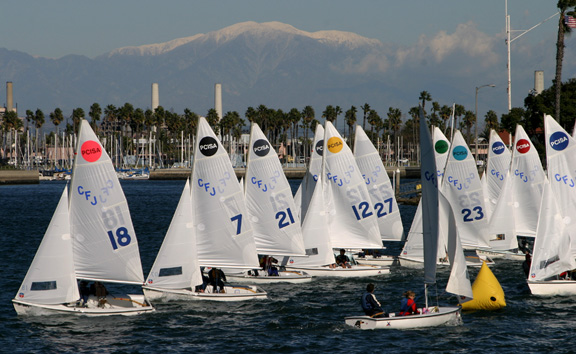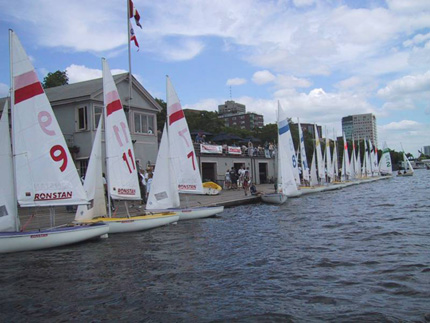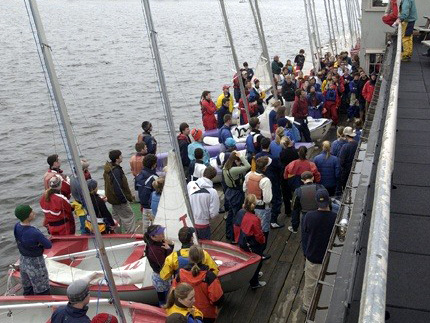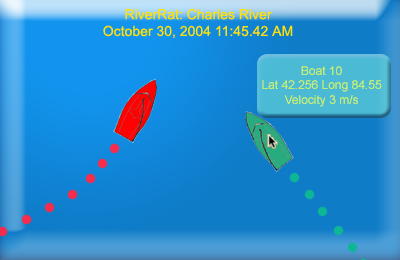
| RiverRat - An MIT iCampus project | http://web.mit.edu/riverrat/ |
The RiverRat project is designing hardware and software for real-time tracking of MIT sailboat on the Charles River. This will allow spectators to watch a bird's-eye view of races on a monitor at the sailing pavilion. The system will also record and playback sailboat tracks for later post-race analysis of tactics, strategy, and performance.
We have one principle goal: to make sailing fun to watch.
While most sailors will tell you that sailing is the most involved and exciting
sport they participate in, it can be difficult to watch, especially for untrained
spectators. This is because racing occurs half a mile from the shore and the
spectators cannot identify their friend or teammates. Even when races take place
close to land, the view that spectators have is highly skewed due to the perspective,
making very difficult to identify what boat is leading and which are trailing.

In contrast, sports like basketball or football are exciting to watch because
spectators can see the action develop and root for the success of their friends.
Sailors have always been looking for a means to increase spectators' interest
in their sport (the organizers of the America's Cup were successful in doing
this by supplementing video coverage of the races with real-time, 3D graphics
from Virtual Spectator.).
Sailing is also a sport difficult to teach, mainly for two reasons. The first
is that when a person goes sailing he or she is on the water for more then two
hours at a time. This makes it very difficult for a coach to discuss a specific
event that occurred on the water, hours before the sailor returns to the dock.
The second is that it is very hard for a coach to convey to a novice sailor
about tacking angles and how to sail upwind the most efficiently. This is because
it is not possible for the sailor to see the course he or she sails upwind in
comparison to the course of a more advanced sailor.
Sailing has also the potential to become quite dangerous. Although while at
the MIT sailing pavilion, one is never further then a quarter of a mile from
the shore people can still get in trouble and need the assistance of the sailing
pavilion staff. The problem is that it is very hard for the pavilion staff to
be constantly vigilant in watching a boat out on the river and this becomes
even more difficult when there are 60 boats on the water. If the dock staff
is not paying attention to a boat, for even thirty seconds, there could be a
situation where someone is in trouble while no one on shore knows about it.
The MIT sailing pavilion currently has two focuses: a recreational sailing program, and a varsity sailing team. The recreational sailing program is in place to teach MIT students how to sail and give them a means of escaping their everyday MIT life by going out on the water for a few hours. This program teaches about seven hundred people how to sail every year, while the number of current students, alumni, and friends who go sailing at the pavilion is around fifteen hundred. The varsity sailing team is, instead, composed of about thirty MIT students. The team sails during the school year from the melting of the ice to the beginning of November. An off-shoot of the sailing team is that almost every weekend during the spring and the fall the pavilion hosts a regatta where between 50 and 200 sailors, coaches, friends, and family members come to the pavilion to sail or watch sailing.


The RiverRat system will be a lightweight, robust, real-time, tracking system for up to 30 boats on the Charles River. The system will be built within the next nine months, in time for the Schell Regatta, which MIT will host on the weekend of October 30. This system will serve to increase spectator involvement and interest by giving them the perspective of a blimp looking down on MIT's boats on the Charles River while setting up the foundation for a system which could aid in educating sailors in racing tactics and sailing skills, and improving boating safety on the Charles River. Not only will RiverRat serve to improve sailing's appeal to spectators, it will be an innovative tool for teaching sailing to both novices and advanced sailors. When the system has been implemented, it will be easy to implement additional functionalities to the tracking devices in order to keep tabs on recreational sailors and to warn the dock staff of capsized or boats in other danger.
